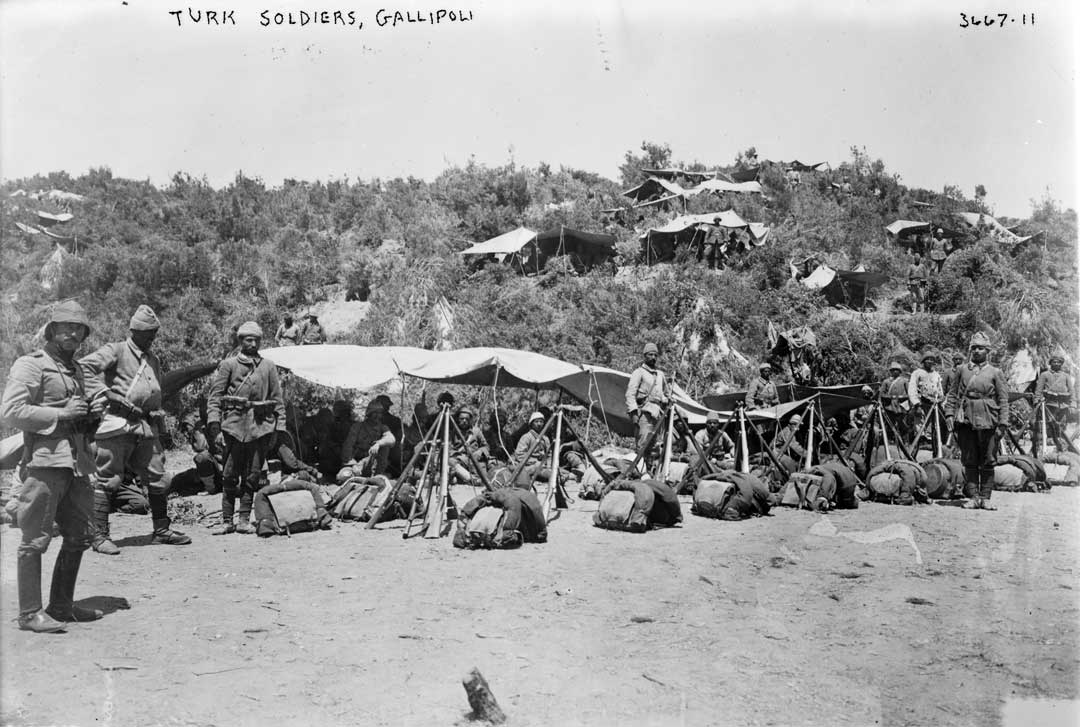Gallipoli Campaign

Ottoman Troops
The Allies hoped to inflict a quick knock out blow to the Ottomans by capturing Constantinople. They were however unable to break through the Straits of Dardanelles with their naval force. They then attempted to capture coast with ground troops, but that campaign ended indecisively and they were forced to withdraw.
The Ottomans were the major allies of the Germans, and allied forces had attacked Ottoman holdings in the Middle East. However, the Ottomans controlled the Dardanelles straits, the entry point into the Black Sea from the Mediterranean and thus an important gateway to Russia. The Allies came up with an ambitious campaign to both secure the passage through the Dardanelles and possibly end the Ottoman involvement in the war. The British and French would sail through the Straits and capture Constantinople (now Istanbul). The allies hope was that with overwhelming naval strength they could break through the defenses of the Dardanelles and make it to Constantinople.
The Allies launched their first attack on February 19th,1915 when British battleships began the long range bombardment of the Ottoman forts along the coast. The initial bombardments were successful despite delays caused by bad weather and by February 25th Royal Marines landed to destroy the remnants of the batteries guarding the entrance to the straits. However many of the Ottoman guns were mobile and it became and more difficult to destroy them. Thus it was decided to launch an all out assault on the narrowest part of the straits. Eighteen British and French battleships together with supporting cruisers and destroyers launched their assault on March 18th, Unfortunately the job of removing the mines had been left to civilian boats and they were not prepared to work under fire from the remaining Ottoman batteries and thus the mines were not cleared. The result was the French battleship Bouvet hit a mine and sunk. The HMS Irressistible and HMS Inflexible were damaged as was the HMS Ocean. Two additional French battleships were also damaged. Some of the officers believed that the ship should keep going despite the losses but others believed that a withdrawal was in order and they prevailed.
With it seemingly impossible to break through with only naval forces it was decided to land forces and secure the Northern shore. On April 25th landings were made by British, Austrian and New Zealand forces at six beaches. The Allies forces faced harder than expected resistance from the Ottomans and although they were able to battle their way inland from the beached, Ottoman reinforcements arrived before they could win a decisive battle. Casualties were high. The Ottoman launched a major counteroffensive on May 19th hoping to dislodge the Allied forces. The Ottomans had hoped to carry the day thinks to the element of surprise, however their movements were spotted by British planes and the Allies decimated their advance with the Ottomans suffering 13,000 casualties. The Allies tried one more offensive campaign in August that failed to make any significant progress.
In early December it was decided to evacuate the area. The last allied forces let the peninsular on the night of January 9, 1916. Ironically in a campaign that nothing seemed to go right, one of the most difficult military maneuvers and withdrawal from a beach head was successfully implemented almost flawlessly.
The campaign had been a total and costly failure. The British lost 43,000 men killed or missing while the Ottomans lost 56,000.
 >
>